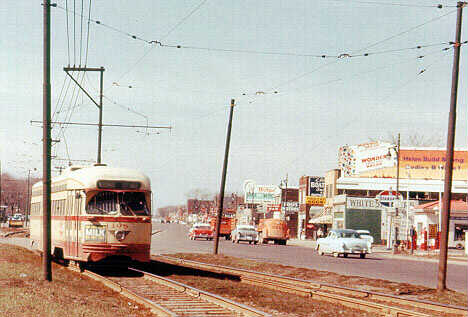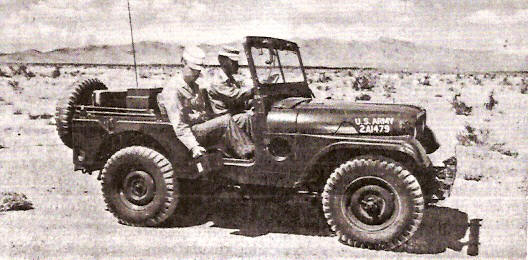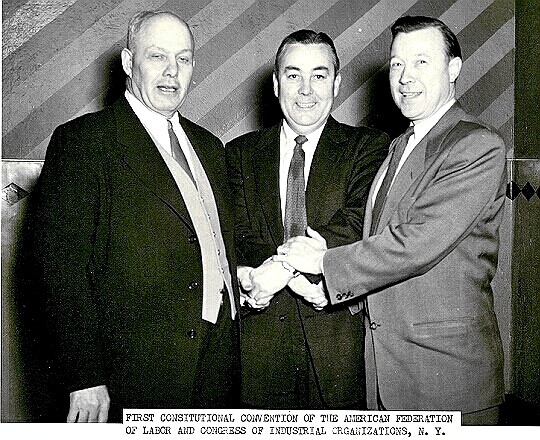I) Political scene
A) 1952 Presidential Election
1) “I Like Ike” – one of the heroes of the Second World War, Dwight D. Eisenhower, who had engineered the Allied victory in Europe
2) 8 Millionaires in the cabinet – displaying the linkage between the military and business from the war years
3) Retained many New Deal programs
B) Cold War on the cheap
1) Reliance upon nuclear weapons
(a) John Foster Dulles – believed that the US needed to remove the taboo from using nuclear weapons
(b) Promise of “Massive Retaliation” – the doctrine of Massive Retaliation advocated by Dulles; the promise of total annihilation should the US ever face a nuclear attack itself (led to the understanding of “Mutually Assured Destruction” on the part of the US and the USSR).
(c) Civil Defense – the ludicrousness of “survival” in the event of nuclear war.
II) Economic and social life in the 1950s
A) Postwar Economic Boom – from the end of WWII to the early 1970s, the US experienced a period of unprecedented economic growth
1) Car Culture – epitomized US society during these years; the car culture emphasized the consumption
(a) Consumption of consumer goods
(b) High wage jobs – (for union members, anyway), which allowed consumers to buy the goods that advertising convinced them that they wanted.
(c) Movement to the suburbs – for whites
(d) Example of Detroit
B) Modified Keynesian economics – government was to use its power to tax and spend in order to regulate the consumer demand for goods and services (example: the price of gasoline, which had been kept artificially low in the US because it was a desirable policy to encourage the purchase of individually owned automobiles, rather than have the price reflect the true social cost of all of the automobiles on the road)
1) Legacy of the New Deal
(a) Liberals – wanted to sustain economic growth by sustaining consumer purchasing power through government spending on programs like public works, schools, housing, Social Security and unemployment insurance.
(b) Conservatives – feared liberal programs would erode market incentives; advocated tax reductions for businesses instead
(c) Stalemate – taxes remained high on business, but government spending on social programs grew slowly; much of the money went into the military build-up, which represented a means of government spending that conservatives found more palatable
2) Labor and social programs
(a) Health insurance – this benefit was bargained for by large unions, because they expected large corporations to balk at paying the costs for this, and would therefore lobby the government with the unions to create a European-styled national health plan—but instead corporations decided to pass the additional costs of theses plans on to consumers who bought the products they manufactured.
(b) Wages – because of contracts, wages grew independently of market pressures, which shortened the length of recessions considerably.
3) Military spending – by 1950, approximately half of the US budget was devoted to the military, and military “needs” affected a large portion of the rest of the budget.
(a) Economic growth – especially in the South and the West Coast, where many military installations were located—and where the industries serving the military re-located—fueled much of the economic growth during this period.
(b) Social programs – Educational programs (like the GI Bill), medical care (VA hospitals), housing (VA loans) all expanded during this period, unconstroversially. Perhaps the post-war program that had the greatest effect on America, the Interstate and Defense Highway Program, was established in 1956 because of the perceived need for the military to be able to move around the country quickly
C) Era of Labor-Management Peace – despite some rather high-profile strikes during the 1950 (like the steel strike in 1959—one of the longest in history, to that point—the era was marked by a new labor-management understanding in their relationship to one another.
(a) Management agrees to high wages for union members
(b) Well-established unions were insulated from assault from corporations
(c) Unions had to accept management decision making power on the shopfloor and in the boardroom
2) Non-competition for workers – corporation in the same industries agree not to compete for labor, which helps to establish the era of pattern bargaining. The rising cost of labor is met, however, by general rise in prices for the goods produced.
(a) Only possible in maturing industries – industries where the number of firms within an industry had already been reduced by attrition and merger
(b) Workers for these larger corporations were protected from inflation by the Cost-of-Living-Adjustment (COLA); first introduced during negotiations between the UAW and GM in 1948
(i) COLA was pegged to the Consumer Price Index (CPI)
(ii) Workers also got 2% “annual improvement factor” designed to give workers a portion of the productivity gains made by corporations.
3) “Treaty of Detroit” – the 1950 UAW/GM contract
(a) Unprecedented five year contract (which the union never repeated, because despite the economic innovations the wage rise did not keep up with inflation)
(b) By the end of the 1950s, COLAs were a feature of even contracts for employees of non-union companies.
4) What price peace?
(a) End of the “wildcat strike” – companies insisted that production be uninterrupted during the life of the contract (like the Treaty of Detroit example)
(b) Company insistence upon longer terms for contracts—which help them control labor costs
(c) All disputes that arose during the life of the contract were to be handled only through official channels—usually through the established grievance process. This meant that union officials became contract police; in effect the union became the arbitrator between the company and its employees, rather than the advocate for its members.
5) Labor merger – in 1955, the AFL and the CIO merged; the new organization was headed by the former president of the AFL, a former plumber named George Meany, who boasted that he had never led a strike.
(a) Merger of unequal partners – at the time of the merger, the AFL was twice the size of the CIO
(b) Labor during this period became increasingly reliant upon the Democratic Party, while receiving less and less for this support.
6) Labor corruption – was especially prevalent in decentralized, highly competitive industries like trucking (Teamsters), restaurant (Restaurant Employees), and dock work (ILA)
D) Deindustrialization
1) Flight from the farm
(a) Mechanization of cotton farming – did away with the need for cheaply employed labor; large landowners began encouraging sharecroppers to move north, to rid themselves of obligations.
(b) Mechanization decreased the need for casual labor – farms that do still need casual labor come to rely more and more upon migrant labor, principally from Mexico and the border area with Mexico.
(c) Black and white farmers and laborers continue to move north during the 1950s












Interesting.IKE enjoyed a period of social renewal and built roads schools and housing using tax bonds and Keynesian policy and it worked.Then on the way out IKE warned the US citizens about The Military Industrial complex and the elite propaganda machine.The Farewell address is on YOUTUBE watch it.The John Birch Society hit on some points of interest too.Welch is great in a John Birch society speech even if I feel he is too overzealous about Socialism.Some European nations are dialing in a new way of thinking that isn't absorbed in All or Nothing Thinking.
ReplyDeleteFDR and IKE were two great presidents two different parties on the same American page in many respects
By the way I just noticed your post was on April 20th of 2011.
ReplyDeleteThat day was quite sad for me my mom passed away that day.
She lived a long life.
Watched history in the making and was proud to be an American.
She was born in Nogales
She didn't like the fence/wall at the border.
It is America's Iron Curtain in the making.
In the name of security.
While PORTS remain a security risk the fence building goes on.
The Priority seems to be racist
Reducing The Supply and Demand in America for drugs is the key
Harm Reduction 501C3 Cannabis Outlets is needed first move coast to coast without delay.
Then realistic addiction maintenance and harm reduction.
Prohibition enables organized crime